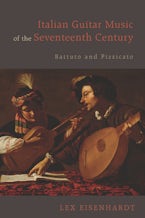
The Great Vogue for the Guitar in Western Europe
1800-1840
- Description
- Contents
- Author
- Blog Post
The first book devoted to the composers, instrument makers and amateur players who advanced the great guitar vogue throughout Western Europe during the early decades of the nineteenth century.
Contemporary critics viewed the fashion for the guitar with sheer hostility, seeing in it a rejection of true musical value. After all, such trends advanced against the grain of mainstream musical developments of ground-breaking (often Austro-German) repertoire for standard instruments. Yet amateur musicians throughout Europe persisted; many instruments were built to meet the demand, a substantial volume of music was published for amateurs to play, and soloist-composers moved freely between European cities. This book follows these lines of travel venturing as far as Moscow, and visiting all the great musical cities of the period, from London to Vienna, Madrid to Naples.
The first section of the book looks at eighteenth-century precedents, the instrument - its makers and owners, amateur and professional musicians, printing and publishing, pedagogy, as well as aspects of repertoire. The second section explores the extensive repertoire for accompanied song and chamber music. A final substantive section assembles chapters on a wide array of the most significant soloist-composers of the time. The chapters evoke the guitar milieu in the various cities where each composer-player worked and offer a discussion of some representative works. This book, bringing together an international tally of contributors and never before examined sources, will be of interest to devotees of the guitar, as well as music historians of the Romantic period.
Contemporary critics viewed the fashion for the guitar with sheer hostility, seeing in it a rejection of true musical value. After all, such trends advanced against the grain of mainstream musical developments of ground-breaking (often Austro-German) repertoire for standard instruments. Yet amateur musicians throughout Europe persisted; many instruments were built to meet the demand, a substantial volume of music was published for amateurs to play, and soloist-composers moved freely between European cities. This book follows these lines of travel venturing as far as Moscow, and visiting all the great musical cities of the period, from London to Vienna, Madrid to Naples.
The first section of the book looks at eighteenth-century precedents, the instrument - its makers and owners, amateur and professional musicians, printing and publishing, pedagogy, as well as aspects of repertoire. The second section explores the extensive repertoire for accompanied song and chamber music. A final substantive section assembles chapters on a wide array of the most significant soloist-composers of the time. The chapters evoke the guitar milieu in the various cities where each composer-player worked and offer a discussion of some representative works. This book, bringing together an international tally of contributors and never before examined sources, will be of interest to devotees of the guitar, as well as music historians of the Romantic period.
Foreword - Richard Savino
Introduction - Christopher Page, Paul Sparks and James Westbrook
Eighteenth-century precedents: the role of Paris - Damián Martín Gil and Erik Stenstadvold
The Great Vogue for the guitar: an overview - Christopher Page
The instrument and its makers - James Westbrook
Printing and publishing music for the guitar with Appendix: Matteo Carcassi - Erik Stenstadvold
Amateurs and professionals - Christopher Page
Teaching and learning the guitar - Erik Stenstadvold
Early-nineteenth-century guitars in the saleroom, private hands and public collections - James Westbrook
Music for early-nineteenth-century guitars in the saleroom, private hands and public collections - Kenneth Sparr
Accompanied song - Jelma van Amersfoort
Chamber music for the guitar - Jukka Savijoki
Ferdinando Carulli (1770-1841) - Mario Torta
Mauro Giuliani (1781-1829) - Gerhard Penn
Fernando Sor (1778-1839) - Erik Stenstadvold
Dionisio Aguado (1784-1849) - Luis Briso de Montiano
Emilia Giuliani (1813-1850) - Nicoletta Confalone
Giulio Regondi (1822/23-1872) and Catharina Pratten née Pelzer (1824-1895) - Sarah Clarke
Appendix: A note on string-making - Jenny Nex
Bibliography
Introduction - Christopher Page, Paul Sparks and James Westbrook
Eighteenth-century precedents: the role of Paris - Damián Martín Gil and Erik Stenstadvold
The Great Vogue for the guitar: an overview - Christopher Page
The instrument and its makers - James Westbrook
Printing and publishing music for the guitar with Appendix: Matteo Carcassi - Erik Stenstadvold
Amateurs and professionals - Christopher Page
Teaching and learning the guitar - Erik Stenstadvold
Early-nineteenth-century guitars in the saleroom, private hands and public collections - James Westbrook
Music for early-nineteenth-century guitars in the saleroom, private hands and public collections - Kenneth Sparr
Accompanied song - Jelma van Amersfoort
Chamber music for the guitar - Jukka Savijoki
Ferdinando Carulli (1770-1841) - Mario Torta
Mauro Giuliani (1781-1829) - Gerhard Penn
Fernando Sor (1778-1839) - Erik Stenstadvold
Dionisio Aguado (1784-1849) - Luis Briso de Montiano
Emilia Giuliani (1813-1850) - Nicoletta Confalone
Giulio Regondi (1822/23-1872) and Catharina Pratten née Pelzer (1824-1895) - Sarah Clarke
Appendix: A note on string-making - Jenny Nex
Bibliography
Hardcover
9781837650330
February 2023
£80.00 / $115.00
Ebook (EPDF)
9781800109070
February 2023
$29.95 / £24.99



